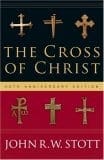Approaching the Cross


I’m really enjoying Stott’s The Cross of Christ. I had a doctor’s appointment this morning and had some time to read it. When the appointment was over and it was time to leave, I had a hard time putting the book away. That’s not always the case with this type of book.
The book is broken into four sections. The first is called “Approaching the Cross.” It offers a survey of Christian history, reflecting on the way that the cross has become the central theme and image of the Christian faith.
In the first chapter, Stott explains why the cross is the central symbol of the Christian faith despite its offensiveness. “Whether their background was Roman or Jewish or both, the early enemies of Christianity lost no opportunity to ridicule the claim that God’s anointed and man’s Savior ended his life on a cross.” The cross was central to Jesus’ thinking, emphasized by the apostles, and this emphasis is also reflected in the church’s tradition.
The second chapter outlines why Christ died. The cross was deliberate. It was intended by the characters involved: Pilate, the religious leaders, and Judas – who are more like us than we’d like to admit. The cross was also deliberate on the part of God. “Though due to human wickedness, it was also due to the set purpose of God, voluntarily accepted by Christ who gave himself up to death.”
The third chapter looks below the surface at why the crucifixion was so important in God’s plan, explaining the central importance that Jesus attached to his death, enforcing three truths: our sinfulness, God’s love, and salvation as a free gift.
Some quotes:
It is important to keep these two complementary ways of looking at the cross. On the human level, Judas gave him up to the priests, who gave him up to Pilate, who gave him up to the soldiers, who crucified him. But on the divine level, the Father gave him up, and he gave himself up, to die for us. As we face the cross, we can say to ourselves both, “I did it, my sins sent him there,” and, “He did it, his love took him there.”
…the cross which…is an exposure of human evil, is at the same time a revelation of the divine purpose to overcome the human evil this exposed.(pp. 64-65)
Why did Jesus Christ die? My first answer is that he did not die; he was killed. Now, however, I have to balance this answer with the opposite. He was not killed; he died, giving himself up voluntarily to do his Father’s will. (p.65)
Nothing reveals the gravity of sin like the cross…It is impossible for us to face Christ’s cross with integrity and not to feel ashamed of ourselves. Apathy, selfishness and complacency blossom everywhere in the world except at the cross. There these noxious weeds shrivel and die. They are seen as the tatty, poisonous things they are. For if there was no way by which the righteous God could righteously forgive our unrighteousness, except that he should bear it himself in Christ, it must be serious indeed. It is only when we see this that, stripped of our self-righteousness and self-satisfaction, we are ready to put our trust in Jesus Christ as the Savior we urgently need. (p.85)





